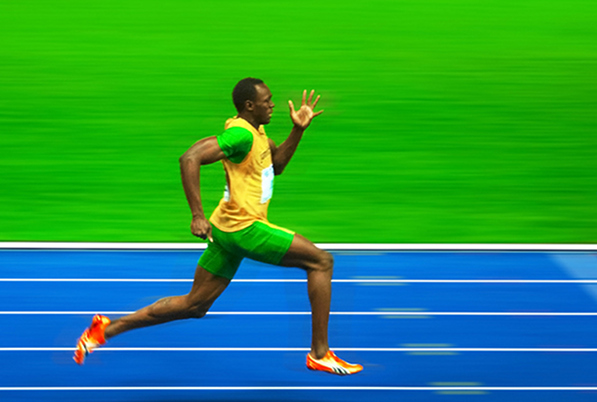
Posted in Injury Prevention, News, Performance Enhancement, Running.
How Strength Training Makes You a Faster Runner
You’ve heard us say it before (hopefully many times): strength training for runners is important to staying healthy and improving performance. Here’s why:
Running speed is the product of stride rate x stride length. Essentially, the faster you can turn over your legs with the longest stride possible produces the fastest runners.
Think of a sprinter like Usain Bolt (and check out his form in the photo). The best sprinters will put the most force against the ground in the fastest time possible (stride rate) and have the biggest range of motion (stride length).
You can improve stride rate by decreasing contact time with the ground, which requires strength and coordination. Typically runners lack the strength and coordination to increase their stride rate, so they increase their stride length.
This works up to a certain point — but the problem is that most runners are also extremely tight and lack the hip mobility for a proper stride. As speed increases, most runners will begin to overstride, increasing risk of injury and causing a decrease in optimal speed.
Have you ever watched professional runners warm up? They do running drills, hopping, skipping, jumping — and they seem to just explode off the ground. They have the coordination and strength to accept their weight against gravity and use the loading of their muscle to explode off the ground.
How do you become a more efficient runner? Strength training, of course. Here are a few principles of strength for runners to consider:
The exercises should look like running.
The main goal is to improve your ability to load against gravity in a way you would when you are running, and then explode from there. Running is upright, against gravity, and on a single leg. Doing a leg press exercise is not as effective as doing a squat because the leg press teaches your muscle receptors to load and explode in a different way than they would when you are running.
The exercises and stretches should be done in 3 planes of motion.
We’re notorious at our clinic for doing everything in all three planes: the sagittal plane (forward and backward), frontal plane (side to side) and transverse plane (rotational). When you run, all of your joints go through three planes of motion. There is almost no muscle in your body that is attached to bone in a way that makes it pull in a singular plane.
Muscles have dominant planes, but why not strengthen the muscle to its fullest potential?
Forward lunging is a great way to increase your glute strength. Next time you do lunges, add in hand reaches to increase the load to the glutes. Reaching forward towards the knee will load the hip in flexion, reaching to the same side will load the hip rotationally in internal rotation and reaching overhead to the opposite side will cause hip adduction.
The exercises should follow the principles of mostability.
Not sure what Mostability refers to? Check out this blog post for a thorough explanation — but essentially, you must gain the range of motion needed for the action first and then strengthen that motion.
In strength training, this is where form comes in. If you are performing an exercise and can’t maintain balance or feel it in the correct spot, then you should not increase weight, range or speed. Your goal will be to move as much weight as possible in the biggest range as possible as fast as you can while staying in control of the movement.
Here are two examples of functional strength exercises for running. One is a variation of a lunge matrix, and the other is a single leg toe touch, which helps with balance. You’ll notice that both are upright — forcing you to work against gravity — while also incorporating different planes of motion; perfect for runners!
Common Lunge Matrix with Same Side Rotational Reach
Single Leg Stance (Toe Touch) with a Lateral Reach
